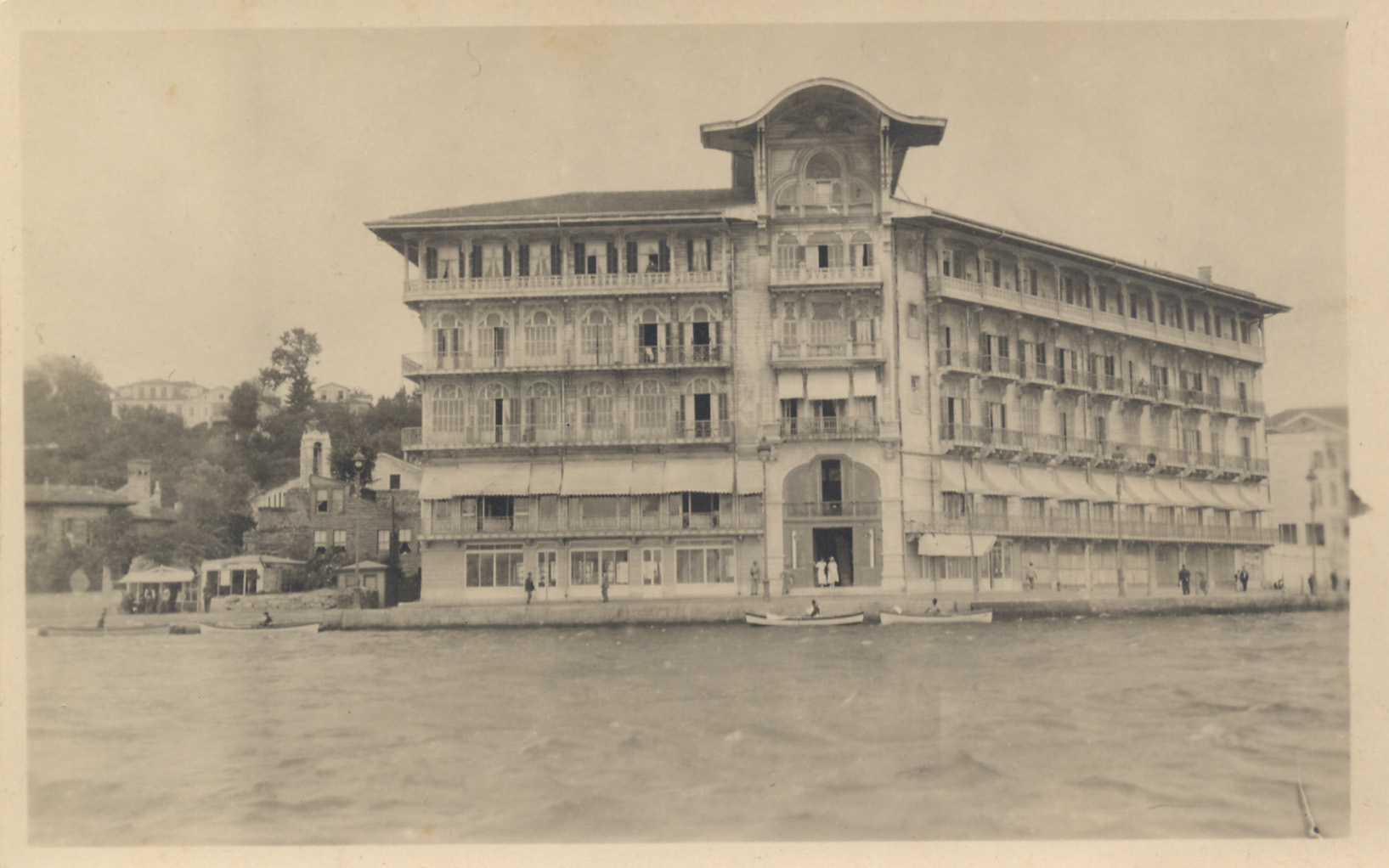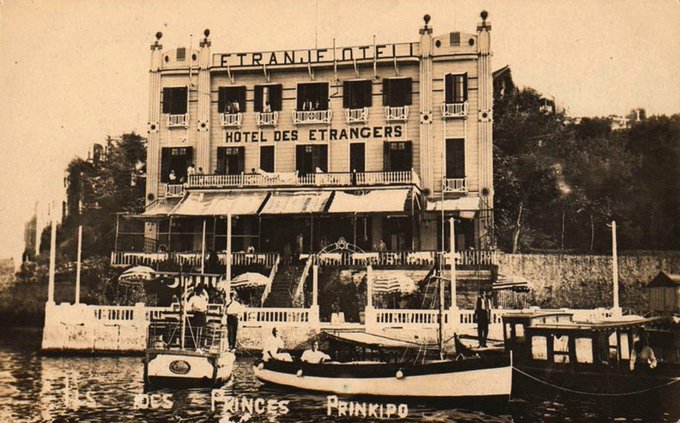Tarabya on:
[Wikipedia]
[Google]
[Amazon]
Tarabya ( ota, Tarabiye, el, Θεραπειά, translit=Therapiá) is a neighbourhood in the Sarıyer district of Istanbul, Turkey. It is located on the European shoreline of the





 Grand Tarabya Hotel (built on the former site of the historic Tokatlıyan Tarabya Hotel)
* Surp Andon Armenian church
* Köstenceli Hacı Osman Mosque
Grand Tarabya Hotel (built on the former site of the historic Tokatlıyan Tarabya Hotel)
* Surp Andon Armenian church
* Köstenceli Hacı Osman Mosque
 * Aydınevler
* Şenevler
* Aydınevler
* Şenevler * Ömertepe
* Ömertepe




 * Bachmann, Martin: ''Tarabya. Alman Büyükelçisi'nin Boğaziçi'ndeki Tarihi Yazlık Rezidansının Tarihçesi ve Gelişimi.'' Alman Arkeoloji Enstitüsü ve Ege Yayınları, Istanbul 2003.
* Türker, Orhan: ''Therapia´dan Tarabya´ya. Boğaz´ın Diplomatlar Köyünün Hikayesi.'' Sel Yayıncılık, Istanbul 2006.
* Bachmann, Martin: ''Tarabya. Alman Büyükelçisi'nin Boğaziçi'ndeki Tarihi Yazlık Rezidansının Tarihçesi ve Gelişimi.'' Alman Arkeoloji Enstitüsü ve Ege Yayınları, Istanbul 2003.
* Türker, Orhan: ''Therapia´dan Tarabya´ya. Boğaz´ın Diplomatlar Köyünün Hikayesi.'' Sel Yayıncılık, Istanbul 2006.
Bosphorus
The Bosporus Strait (; grc, Βόσπορος ; tr, İstanbul Boğazı 'Istanbul strait', colloquially ''Boğaz'') or Bosphorus Strait is a natural strait and an internationally significant waterway located in Istanbul in northwestern Tu ...
strait
A strait is an oceanic landform connecting two seas or two other large areas of water. The surface water generally flows at the same elevation on both sides and through the strait in either direction. Most commonly, it is a narrow ocean channe ...
, between the neighbourhoods of Yeniköy and Kireçburnu. It is famous for its coastal fish restaurants.
Geography
Compared to other neighborhoods in Sarıyer, Tarabya has much more greenery and fresher air thanks to the northern winds coming from the sea. With its massive oak tree, the Huber Mansion and a marina which houses tens of boats and yachts, it is one of the most famous neighborhoods in Istanbul. Some of the areas now controlled by the Marmara University used to be the waterside mansion of Alexander Ypsilantis. Ther last station of the M2 (Istanbul Metro), Hacıosman (Istanbul Metro) is located here, approximately 3 kilometers from the coast.History
The area used to be called Pharmakia. This name is believed to have been given here by Medea, the names means "poison" in Ancient Greek. According to tradition, Attikos, an Orthodox patriarch was uncomfortable with the name being related to poison, so changed it to "Therapia". Therapia was conquered by the Ottomans in 1453. Then a minor Byzantine castle, it fell during the first few days of theFall of Constantinople
The Fall of Constantinople, also known as the Conquest of Constantinople, was the capture of the capital of the Byzantine Empire by the Ottoman Empire. The city fell on 29 May 1453 as part of the culmination of a 53-day siege which had begun o ...
, and 40 Roman soldiers surrendered. They were hanged while the siege was ongoing. 

An Ottoman traveler, Evliya Çelebi, told about his visits to this abandoned place to SultanSelim II Selim II ( Ottoman Turkish: سليم ثانى ''Selīm-i sānī'', tr, II. Selim; 28 May 1524 – 15 December 1574), also known as Selim the Blond ( tr, Sarı Selim) or Selim the Drunk ( tr, Sarhoş Selim), was the Sultan of the Ottoman Empire ..., and how he fell in love with it, and how he fixed it up and opened it to new settlers, which he named "Tarabya". According to his writings: "In the past, there was a fishing area on the seashore. There was no other structure. While Selim II was wandering around the seaside, he stopped by this fishing place and caught various kinds of fish, there are many cypress trees in that place, he cooked freshly caught fish and drank in the shade of those cypresses and had fun. Then he gave an order to Grand Vizier Mehmed Pasha and said, 'Build me a town in this area, let it be named Tarabya." According to him, the village called Tarabya had 800 houses with 7 christian and a single muslim neighborhood. During the reign of Murad IV, much like many other places on the Bosphorus it was raided byRussian Cossacks The Cossacks , es, cosaco , et, Kasakad, cazacii , fi, Kasakat, cazacii , french: cosaques , hu, kozákok, cazacii , it, cosacchi , orv, коза́ки, pl, Kozacy , pt, cossacos , ro, cazaci , russian: казаки́ or .... While in the 17th century it was known as a Greek Orthodox village, over a hundred years later it was noted that a few Armenians and Muslims also lived there. Over time, it turned into a tiny fishing village almost completely inhabited by Orthodox Christians. The village was completely transformed after becoming the centre of the Terkos Metropolis in 1655, and thanks to its new religious position and relative proximity to Constantinople, became one of the most important settlements on the European side of the Bosphorus. Due to its great climate and safety from diseases such as Cholera, many members of the Greek aristocracy moved their place of residence here. Many foreign embassies and merchants also started to move here. It eventually became the favourite place of the ruling Greek class in Constantinople. Some Greek families protected their property here until1821 Events January–March * January 21 – Peter I Island in the Antarctic is first sighted, by Fabian Gottlieb von Bellingshausen. * January 28 – Alexander Island, the largest in Antarctica, is first discovered by Fabian Gottlieb von Be ..., after which they were confiscated. For example the German and French summer palaces used to belong to Greek families. The town remained mostly Greek until around the middle of the 20th century. According to Christoforos Kristidis, in 1955, Tarabya had 144 families and the Greeks maintained a primary school, a boarding school and a sports club. During the Istanbul pogrom, a church built in 1796 was put to fire. Some of the icons were transferred to a nearby church. Later, due to the worsening Turkish-Greek relations and theinvasion of Cyprus The Turkish invasion of Cyprus began on 20 July 1974 and progressed in two phases over the following month. Taking place upon a background of intercommunal violence between Greek and Turkish Cypriots, and in response to a Greek junta-spo ..., most Greeks were forced to move out. The Greek school was closed down in 1985. Around this time, around 50 Greeks -mostly elderly- lived in Tarabya.
Sights
Tarabya has many historical buildings. Churches, hotels, foreign palaces and fountains, their history dates all the way back to the 17th century. The former residence of the Metropolitan used to be right next where the Grand Tarabya Hotel is located now. A former popular hotel, Sümer Palas, built in the 1890s was demolished in the 1950s, and a new apartment complex with the same name lies there now. Hotel d'Angleterre was also built here during the Crimean War. Later in its place was built the Tokatlıyan Hotel, which got burned down in 1954. The Grand Tarabya Hotel, built in its place is the only current hotel in the neighborhood, which opened in 1966. The two notable parks are: Atsushi Miyazaki Park and Şalcıkır park. Atsushi Miyazaki Park is dedicated to a Japanese volunteer in the2011 Van Earthquake
The 2011 Van earthquakes occurred in eastern Turkey near the city of Van. The first earthquake happened on 23 October at 13:41 local time. The shock had a magnitude of 7.1 and a maximum Mercalli intensity of VIII (''Severe''). It occurred at a ...
. Şalcıkır park is a minor park built next to the Tarabya stream. It has a children's area, basketball court and a few fitness machines. The main historical mosque is the Köstenceli Hacı Osman Mosque. The two main historical fountains are the Bezm-i Alem Valide Sultan fountain and the Sultan Mahmud II fountain. Three holy wells were also present here, two of which still exist, they are: Aya Marina, Aya Ioannis and Aya Kiriaki, which is currently in the Atsushi Miyazaki Park.
Some notable sights include:
* Church of Aya Paraskevi
* Fountain of Sultan Mahmud II
* Fountain of Bezm-i Alem Valide Sultan
* Tarabya Cultural Academy, former summer residence of the German Embassy
* Huber Mansion (currently used as the Presidential
President most commonly refers to:
*President (corporate title)
*President (education), a leader of a college or university
* President (government title)
President may also refer to:
Automobiles
* Nissan President, a 1966–2010 Japanese fu ...
residence in Istanbul)
* Yalı
A yalı ( tr, yalı, from Greek ''yialí'' (mod. ''yialós''), literally "seashore, beach") is a house or mansion built right on the waterside (almost exclusively seaside, particularly on the Bosphorus strait in Istanbul) and usually built with ...
of Hristaki Zoğrafos
Christakis Zografos ( el, Χρηστάκης Ζωγράφος, tr, Hristaki Zoğrafos Efendi; 1820 – 19 August 1898) was an Ottoman Greek banker, benefactor and one of the distinguished personalities of the Greek community of Constantinople (m ...
* Yalı of Prince Ypsilantis
The House of Ypsilantis ( el, Υψηλάντης; ro, Ipsilanti) was a Greek Phanariote family which grew into prominence and power in Constantinople during the last centuries of Ottoman Empire and gave several short-reign '' hospodars'' to the ...
(later summer residence of the French Embassy)
* 

 Grand Tarabya Hotel (built on the former site of the historic Tokatlıyan Tarabya Hotel)
* Surp Andon Armenian church
* Köstenceli Hacı Osman Mosque
Grand Tarabya Hotel (built on the former site of the historic Tokatlıyan Tarabya Hotel)
* Surp Andon Armenian church
* Köstenceli Hacı Osman Mosque
Districts
* Hacıosman * Kalender * Aydınevler
* Şenevler
* Aydınevler
* Şenevler * Ömertepe
* Ömertepe
Education

Lycée Français Pierre Loti d'Istanbul
Lycée Français Pierre Loti d'Istanbul is an international French school located in Istanbul
)
, postal_code_type = Postal code
, postal_code = 34000 to 34990
, area_code = +90 212 (European side) +90 216 ...
and Tarabya British Schools
Tarabya British Schools (often abbreviated as TBS) also Özel Tarabya İngiliz Okulları (Turkish) is a private School in Tarabya and Yeniköy, Istanbul, that offers both national and international education through an integrated curriculum to bo ...
both have high school campuses in Tarabya.


See also
*Emirgan
Emirgan is a leafy, middle-class suburb of Istanbul, Turkey, on the western shore of the Bosphorus in the Sarıyer district north of the Fatih Sultan Mehmet Bridge (Second Bosphorus Bridge).
The name commemorates a friendship that eventually turne ...
* Rumelihisarı

References
http://constantinople.ehw.gr/Forms/fLemmaBodyExtended.aspx?lemmaID=11397 http://www.sariyermanset.com/iste-6-7-eylul-olaylarinin-isleri-462h.htm https://bizansconstantin.com/2014/02/07/kaybolan-metropolitlik-binasi-aya-yorgi-kilisesi-ve-therapia/ http://www.loc.gov/pictures/item/2001699655/ https://bizansconstantin.com/2014/02/07/kaybolan-metropolitlik-binasi-aya-yorgi-kilisesi-ve-therapia/ * Bachmann, Martin: ''Tarabya. Alman Büyükelçisi'nin Boğaziçi'ndeki Tarihi Yazlık Rezidansının Tarihçesi ve Gelişimi.'' Alman Arkeoloji Enstitüsü ve Ege Yayınları, Istanbul 2003.
* Türker, Orhan: ''Therapia´dan Tarabya´ya. Boğaz´ın Diplomatlar Köyünün Hikayesi.'' Sel Yayıncılık, Istanbul 2006.
* Bachmann, Martin: ''Tarabya. Alman Büyükelçisi'nin Boğaziçi'ndeki Tarihi Yazlık Rezidansının Tarihçesi ve Gelişimi.'' Alman Arkeoloji Enstitüsü ve Ege Yayınları, Istanbul 2003.
* Türker, Orhan: ''Therapia´dan Tarabya´ya. Boğaz´ın Diplomatlar Köyünün Hikayesi.'' Sel Yayıncılık, Istanbul 2006.
External links
* http://www.sariyer.bel.tr/anasayfa {{Authority control Neighbourhoods of Sarıyer Bosphorus